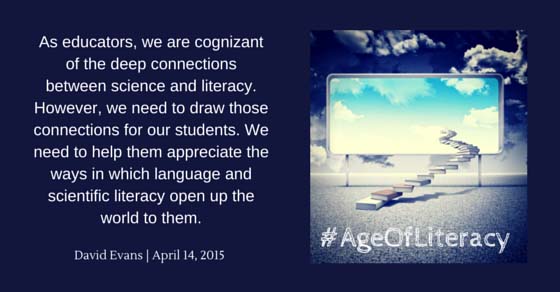Science and Literacy: Reflections on Time
By David Evans, NSTA Executive Director
Posted on 2015-04-13
Science and literacy are inherently linked in so many ways. Just as a matter of practice, scientists must possess great proficiency in reading dense, data-filled texts. They must be expert technical writers who can describe their proposed studies for funding considerations, detail their experimental protocols for their peers to replicate, and summarize their work for general audiences. More crucial to furthering the study of science, they must be confident in their abilities to argue from evidence, both orally and on paper, or, in the parlance of the Next Generation Science Standards (NGSS), they must be able to “obtain, evaluate, and communicate information” and “engage in argument from evidence.”
For some time the National Science Teachers Association (NSTA) has recognized similarities in the ways in which both reading and science are taught and has advocated the powerful reciprocal value of linking science and literacy in the classroom. As reported in Science for English Language Learners, “science and language become interdependent, in part because each is based on processes and skills that are mirrored in the other. These reciprocal skills give teachers and students a unique leverage: by merging science and language in the classroom, teachers can help students learn both more effectively.” This conclusion was drawn while studying the integration of learning English as a second language and the learning of science (see also Teaching Science to English Language Learners). However, the mutually beneficial outcomes have held true with native speakers as well. Using literacy teaching strategies during science instruction “not only provided teachers with tools for guiding students’ interactions with texts and with physical inquiry, but also motivated students to engage with the texts and provided a window into student thinking” (Linking Science and Literacy).
Equally compelling is the research supporting the use of science to pique the interests of reluctant readers, particularly with regard to nonfiction texts. As the authors of Inquiring Scientists, Inquiring Readers assert, “Scientific inquiry provides an authentic context for reading, writing, and dialogue. Having a compelling reason to read a book, record observations, and communicate with others increases students’ motivation to engage in nonfiction reading.”
Perhaps most noteworthy for time-strapped teachers, science is the perfect vehicle for imparting not just science knowledge but also reading and even math. The tremendous popularity of our Picture-Perfect Science program, “Teaching Through Trade Books” column, and annual list of Outstanding Science Trade Books are testament to that!
As educators, we are cognizant of the deep connections between science and literacy. However, we need to draw those connections for our students. We need to help them appreciate the ways in which language and scientific literacy open up the world to them. Literature and science—and for that matter, philosophy and the arts—offer different vantage points from which to tackle some of the same phenomena.
Take, for example, an enduring challenge for physicists, a problem known as “times’ arrow,” the fact that “all the equations that best describe our universe work perfectly if time flows forward or backward.”(Alan Alda launched a competition that encouraged middle school students to explore this very question and required them to communicate their scientific ideas in a clear and engaging manner.) A contemporary summary is in a recent Scientific American article. As I read the essay, I recalled the opening lines from T.S. Eliot’s “Burnt Norton”:
Time present and time past
Are both perhaps present in time future
And time future contained in time past.
Eliot wrestles with time as an abstract concept, exploring our perceptions and their implications with subtlety and nuanced diction instead of as equations. Still, he uses literature as a mechanism for approaching an everyday phenomenon, time, in much the same way a scientist uses an equation or model to describe the world. Neither the poet nor the physicist can offer a definitive answer, but their perspectives are equally valuable as catalysts for deeper thought.
In other words, the connection between science and literacy can be simple, elegant, two different approaches to marveling over the same phenomenon. Reading, writing, and science (not to mention math, social studies, music, and art) play equally important roles in preparing our students to be thoughtful and responsible world citizens. Our parsing of knowledge into subjects typically demands that we teach these subjects as disparate lessons, but provides even more reason to help students make those important connections, such as that between literacy and science. After all, what is science but a tantalizing story of discovery and prediction that unfolds as generations of thinkers encounter phenomenon, seek explanations, and communicate their findings?
 David Evans is Executive Director of the National Science Teachers Association
David Evans is Executive Director of the National Science Teachers Association
The mission of NSTA is to promote excellence and innovation in science teaching and learning for all.
Follow NSTA
Disclaimer: The views expressed in this blog post are those of the author(s) and do not necessarily reflect the official position of the National Science Teaching Association (NSTA).



